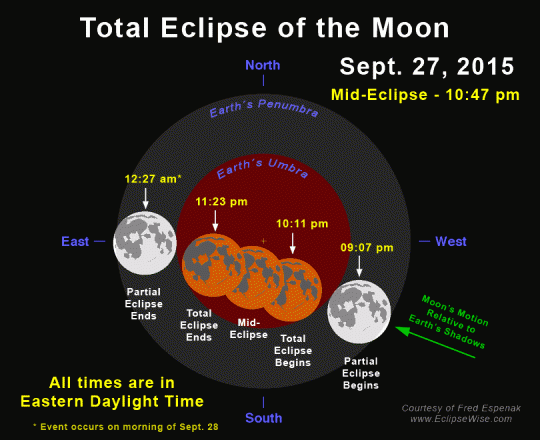A total lunar eclipse will spawn a rare and dramatic ‘supermoon’ blood moon this Sunday, Sept. 27. First, the moon will be full, as it always must be for a lunar eclipse to occur. This is a special full moon, because this is the Harvest Moon. Because the angle of the ecliptic —the path the moon and planets follow across the sky —is low to the horizon, the moon rises about the same time every night, giving farmers an extra supply of light when they most need it, at harvest time.
Second, the full moon will be at its closest to Earth in all of 2015, what is known to astronomers as a “perigee moon.” In recent years this has become known as a “supermoon.” Perigee (meaning “closest to Earth”) occurs at 10 p.m. EDT, the moon being a mere 222,374 miles away.
This Sunday’s lunar eclipse is a true total eclipse, with the moon being in the umbra (the moons’ darker inner part) for a full 1 hour and 22 minutes.
Here are the important times in Eastern Daylight Time.
- 8:11:46 p.m. — Moon enters penumbra
- 9:07:12 p.m. — Moon enters outer edge of umbra
- 10:11:11 p.m. — Moon completely in umbra (beginning of total eclipse)
- 10:47:09 p.m. — Mid-eclipse (This is the time of the greatest eclipse)
- 11:23:07 p.m. — Moon begins to emerge from umbra (End of total eclipse)
- 12:27:06 a.m. — Moon completely out of umbra
- 1:22:33 a.m. — Moon leaves penumbra
- One of the wonderful things about lunar eclipses is that they are completely safe to view with the naked eye. No special filters are required to protect your eyes like those used for solar eclipses. You don’t need a telescope to watch the eclipse, although a good pair of binoculars will enhance your experience.
http://www.space.com/30627-lunar-eclipse-blood-moon-triple-treat.html


